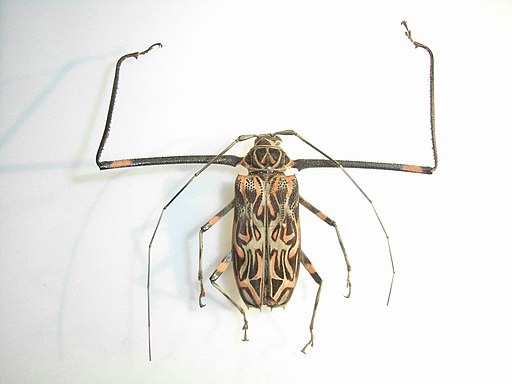Acrocinus longimanus, Male
Acrocinus longimanus, Female
Superregnum: Eukaryota
Regnum: Animalia
Subregnum: Eumetazoa
Cladus: Bilateria
Cladus: Nephrozoa
Cladus: Protostomia
Cladus: Ecdysozoa
Cladus: Panarthropoda
Phylum: Arthropoda
Subphylum: Hexapoda
Classis: Insecta
Cladus: Dicondylia
Subclassis: Pterygota
Ordo: Coleoptera
Subordo: Polyphaga
Infraordo: Cucujiformia
Cladus: Phytophaga
Superfamilia: Chrysomeloidea
Familia: Cerambycidae
Subfamilia: Lamiinae
Tribus: Acrocinini
Genus: Acrocinus
Species: Acrocinus longimanus
Name
Acrocinus longimanus (Linnaeus, 1758). ZooBank
Synonyms
Basionym
Cerambyx longimanus
References
Primary references
Linnaeus, C. 1758. Systema Naturae per regna tria naturæ, secundum classes, ordines, genera, species, cum characteribus, differentiis, synonymis, locis, Tomus I. Editio decima, reformata. Holmiæ: impensis direct. Laurentii Salvii. i–ii, 1–824 pp DOI: 10.5962/bhl.title.542: 388. Reference page.
Additional references
ZooBank: 61C1FD8A-621F-4DE4-8CF7-28C6713F0183
Zeh, D.W.; Zeh, J.A.; Bonilla, M.M. 2003: Phylogeography of the giant harlequin beetle (Acrocinus longimanus). Journal of biogeography, 30(5): 747–753. DOI: 10.1046/j.1365-2699.2003.00880.x
Vernacular names
Deutsch: Harlekinbock
English: Harlequin Beetle
português: Besouro-da-figueira
русский: Длинноногий арлекин
The harlequin beetle (Acrocinus longimanus) is a tropical longhorn beetle native from southern Mexico to Uruguay.[1] The harlequin beetle feeds on sap and is given this name because of its elaborate pattern of black, red and greenish yellow markings on the wing covers of both sexes.[2] The species name longimanus is a Latin word that refers to the extremely long forelegs (manus) of the males, which are usually longer than the beetle’s entire body. As an adult, the species is very large, with a body that can measure nearly 76 mm (3 inches) in length.[3] It is also famous for carrying pseudoscorpions as a form of phoresy.
The harlequin beetle exhibits sexually dimorphic traits. Males have cephalic horns used in combat which are poorly developed or absent in females or enlarged mandibles. Dimorphism also occurs in the shape of the foreleg tibia which is nearly straight in females and exhibits varying degrees of curvature in males.[4]
The harlequin beetle contains three homologous peptides, Alo-1, Alo-2, and Alo-3. Alo-3 is the first peptide from insects that exhibits the knottin fold and shows a higher level of activity against the fungal species (Candida glabrata) than the Alo-1 and Alo-2 peptides. Currently, there is a lack of treatment for fatal hospital-acquired infections and other pathologies. The peptide Alo-3 found in Harlequin beetles could provide a treatment for these severe, life threatening infections.[5]
References
Henderson, Carrol L.; Janzen, Daniel H. (2010). Butterflies, Moths, and Other Invertebrates of Costa Rica: A Field Guide. University of Texas Press. p. 130. ISBN 978-0-292-71966-8. Retrieved 24 Jan 2011.
Evans, Arthur V.; Bellamy, Charles L. (2000). An inordinate fondness for beetles. University of California Press. p. 130. ISBN 978-0-520-22323-3. Retrieved 24 Jan 2011.
"Harlequin beetle." Encyclopædia Britannica Online.
Zeh, D., Zeh, J., & Tavakilian, G. (1992). Sexual Selection and Sexual Dimorphism in the Harlequin Beetle Acrocinus longimanus. Biotropica, 24(1), 86-96. doi:10.2307/2388476
https://pubs.acs.org/doi/pdf/10.1021/bi035400o "Solution structure of Alo-3: A new knottin-type antifungal peptide from the insect Acrocinus longimanus"
Further reading
Zeh, David W.; Zeh, Jeanne A.; Bonilla, Melvin M. (2003). "Phylogeography of the giant harlequin beetle (Acrocinus longimanus)". Journal of Biogeography. 30 (5): 747–753. doi:10.1046/j.1365-2699.2003.00880.x. ISSN 0305-0270.
Zeh, David W.; Zeh, Jeanne A.; Tavakilian, Gerard (1992). "Sexual Selection and Sexual Dimorphism in the Harlequin Beetle Acrocinus longimanus". Biotropica. 24 (1): 86–96. doi:10.2307/2388476. ISSN 0006-3606. JSTOR 2388476.
Retrieved from "http://en.wikipedia.org/"
All text is available under the terms of the GNU Free Documentation License



